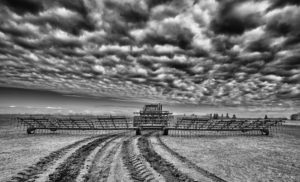 President Donald Trump’s ongoing trade war with China is taking its own toll on the ag industry. But it has come at a time of unprecedented weather events, and the phenomena are a one-two punch.
President Donald Trump’s ongoing trade war with China is taking its own toll on the ag industry. But it has come at a time of unprecedented weather events, and the phenomena are a one-two punch.
John Deere, one of the largest ag financers in the United States, reported mixed results in the third quarter (ending July 28), which executives chalked up to market disruptions and wet fields. The challenges “have partially overshadowed a heightened outlook for farm incomes in the United States,” said Brent Norwood of John Deere investor communications. “Meanwhile, some foreign markets such as Brazil have showed continued signs of strength as strong crop production and increased exports have benefited the local industry.”
Luke Chandler, John Deere’s chief economist, said major farm economies around the world are expected to be on par with last year, which will help buoy uncertainty in the United States.
“While ongoing market access issues have been detrimental to the North American farmer confidence, increased export opportunities emerged for farmers in other parts of the world, notably Brazil and Argentina,” Chandler said. “But in the United States, 2019 has been a volatile year for farmers, particularly those in the Corn Belt.”
The U.S. row crop sector started the year with the USDA forecasting corn stocks would achieve the highest level in more than 30 years, Chandler said. But cold spring temperatures and flooding delayed planting across major corn and soybean growing regions. “The result was heightened uncertainty around row crop production,” he said.
In response, the USDA has tamped down its stock outlook.
Farmers have been receiving payments from the $14.5 billion Market Facilitation Program, authorized by the President. These payments are keeping many farms afloat but not doing a whole lot for confidence in the markets.
“Higher levels of uncertainty regarding final planted and harvested acreage, yield, and MFP details have contributed to a wide swing in farmer sentiments throughout the season,” Chandler said.
A survey of ag banks, conducted by the Federal Reserve Bank of Kansas City and released in August, shows the Tenth District farm economy remained weak in the second quarter, but farm income and credit conditions showed some signs of stabilizing. Bankers predicted farm income would continue to trend downward in 2019, although the speed of decline is expected to lessen. Bankers reported that deposits grew at a faster pace in some states while farmland values remained steady.
Demand for ag loans remained high in that District during the first half of the year, but bankers see that slowing. “The extended period of low farm income and strong farm loan demand likely has placed downward pressure on liquidity at some banks,” the survey stated. “However, over 80 percent of respondents continued to indicate that availability of funds was unchanged from a year ago and looking ahead, nearly no change was expected across the region.”
Under the circumstances it is no surprise that various forms of crop insurance products are being used in high numbers. In August, Farm Credit Mid-America, a large ag finance cooperative with customers in Indiana and Ohio, was encouraging its members to investigate Margin Protection, the federally-affiliated crop insurance option. Indiana experienced a historically soggy spring, and unfortunately another form of crop insurance, Prevented Planting, has been widely put to use.
“This is really hitting home and forcing our customers to make difficult decisions,” said Lindsey Walls, crop insurance specialist for Farm Credit Mid-America. “We are constantly on the phone and driving out to visit our customers’ farms to talk to them about their unique situation and help them make the best decisions given their individual circumstances. No farmer enjoys seeing their ground sit idle. They want to see a crop growing. For the first time in a long time, we’re seeing a situation where they may have absolutely no other option than to file for prevented plant.”
In August, the USDA announced forthcoming additional assistance for Prevented Planting and other forms of crop insurance aimed at continuing relief programs though next year. The agency also said it would defer accrual of interest for all agricultural producers’ spring 2019 crop year insurance premiums.
